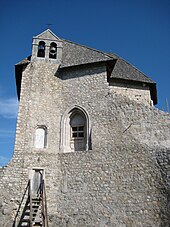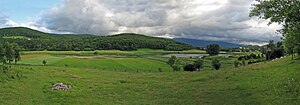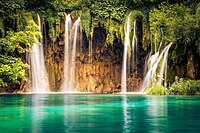Lika
Lika | |
|---|---|
 Approximate region of Lika within Croatia | |
| Country | |
| Largest city | Gospić |
| Area | |
| • Total | 5,283 km2(2,040 sq mi) |
| Population (2011) | |
| • Total | 50,927 |
| • Density | 9.6/km2(25/sq mi) |
| • Total % of Croatia | 1.19% |
| • Ethnic groups | Croats84.15%Serbs13.65% |
| Demonym | Licaners |
| Time zone | UTC+1(CET) |
| • Summer (DST) | CEST |
Lika(Croatian pronunciation:[lǐːka]) is a traditional region[2]ofCroatia proper,roughly bound by theVelebitmountain from the southwest and thePlješevicamountain from the northeast. On the north-west end Lika is bounded by Ogulin-Plaški basin, and on the south-east by the Malovan pass. Today most of the territory of Lika (Brinje,Donji Lapac,Gospić,Lovinac,Otočac,Perušić,Plitvička Jezera,UdbinaandVrhovine) is part ofLika-Senj County.Josipdol,PlaškiandSaborskoare part ofKarlovac CountyandGračacis part ofZadar County.
Major towns includeGospić,Otočac,andGračac,most of which are located in thekarstpoljesof the rivers ofLika,Gackaand others. ThePlitvice LakesNational Parkis also in Lika.
History
[edit]Antiquity
[edit]Since the first millennium BC the region was inhabited by theIapodes,an ancient people related toIllyrians.During theGallic invasion of the Balkans,a division of the Gallic army passed through the territory of today's Lika and a part of this army settled among the Iapodes.
In the 2nd century BC, Iapodes came into conflict with theRoman Empire,suffering several military campaigns, most significantly in 129 BC, 119 BC and finally being conquered in 34 BC byAugustus Caesar.[3]
Medieval
[edit]
Bijelohrvati (orWhite Croats) originally migrated fromWhite Croatiato Lika in the first half of the 7th century. After the settlement of Croats (according to migrations theories), Lika became part of thePrincipality of Littoral Croatia. Lika then became a part of theKingdom of Croatiain 925, whenDuke Tomislavof the Croats received the crown and becameKing of Croatia.
The name of Lika is derived from oldIllyrian language,meaning "body of water"; itscognatesareliquor( "fluid" ) inLatinandliqén( "lake" ) in modernAlbanian.Indeed, a major feature of the Lika landscape are rivers and lakes, as well asmarshesandfloodplains,many of which have been drained in 18th to 20th centuries. The name initially referred toLika River,and over time came to denote the region.[4]The first mention of Lika as a toponym appears in 10th-centuryConstantine Porphyrogenitus' bookDe Administrando Imperioasβο(ε)άνος,in a chapter dedicated to Croats and the organisation of their state, describing how theirban"has under his ruleKrbava,Lika andGacka".[5][6]
Among the twelve noble Croat tribes that had a right to choose the Croat king, theGusićtribe was from Lika. The ethnonymGuduscanimentioned in medieval sources was also thought to be related to Lika.
From the 15th century
[edit]
In 1493 the Croatian army suffered a heavy defeat from the Ottoman forces in theBattle of Krbava Field,nearUdbinain Lika. As the Ottomans advanced into Croatia, the Croatian population from the region gradually started to move into safer parts of the country or abroad.[7]Many indigenousChakaviansof Lika leaving this area and to their places mainly arriving Neo-Shtokavian Ikavians from western Hezegovina and western Bosnia, and Orthodox (Vlachs and Serbs Neo-Shtokavian Ijekavians) from south-east of Balkan Peninsula.[8]In 1513 the town ofModruš,the location of theepiscopal seein Lika, was overrun by the Ottomans.[9]In 1527 they captured Udbina, including theUdbina Castle,leaving most of Lika under Ottoman control.[10]The region became initially partSanjak of Bosnia,later theSanjak of Klisand finally theSanjak of Krka.The devastation of Lika and Krbava was such that almost half a century they remained largely uninhabited. At the end of the 16th century the Ottomans started settlingVlachsin the area, as well as Muslims in larger settlements where they soon formed a majority of the population.[11]
Prince Radic was appointed Prince of Senj by King Rudolf in Graz (1 December 1600). Radic family is a Native noble family from Lika region; members of the family were Uskok military leaders at the headquarters in Senj. Prince of Senj was very active against Ottoman. In 1683 after Ottoman defeat at the battle of Vienna, 30,000 Muslims from Lika began to move towards Bosnia. Large number of these Muslims originated from Bosnia from which they came a century earlier, while a substantial proportion was of Croatian origin.[12]
The Ottoman rule in Lika mostly ended in 1689 with the recapture of Udbina. However area ofDonji Lapacremained in Ottoman hands for 102 years.[13]The borders between the Habsburg Monarchy and the Ottoman Empire were initially concluded with theTreaty of Karlowitzin 1699,[14]finally concluded withTreaty of Sistovain 1791. Lika was incorporated into the Karlovac general command of theCroatian Military Frontier.It was repopulated by immigrants from Ottoman held regions. Catholics predominated in urban settlements, while Orthodox Christians were mostly present in the interior of Lika.[15]
On 15 July 1881 theMilitary Frontierwas abolished, and Lika was restored toKingdom of Croatia-Slavonia,an autonomous part ofTransleithania(the Hungarian part of the Dual Monarchy ofAustro-Hungary). It was within theLika-Krbava County,with Gospić as the county seat. Its population was ethnically mixed and in 1910 consisted of 50.8% Serbs and 49% Croats.[16]
Kingdom of Yugoslavia to SFRY
[edit]After the collapse of Austria-Hungary, Croatia and Slavonia, of which Lika was part, became part of theState of Slovenes, Croats and Serbson October 29, 1918. The newly created state then joined theKingdom of Serbiaon December 1, 1918 to formKingdom of Serbs, Croats and Sloveneswhich was in 1929 renamed into Yugoslavia. Lika remained inside Croatia, which became one of the constituent provinces of the Kingdom. The majority of Lika belonged to theŽupanija Lika-Krbavawith the capital inSenj(instead of inGospićpreviously). The new constitution abolished any previous borders and Lika became a part of thePrimorsko-krajiška Oblastwith the capital inKarlovac.In 1929, the region became a part of theSava Banate(Savska banovina) of the newly formedKingdom of Yugoslavia,and then in 1939 of theCroatian Banate(Hrvatska banovina).
Yugoslavia was invaded and split by theAxisforces in 1941 and Lika became a part of theIndependent State of Croatia(NDH), an Axis puppet state led by theUstaše.On 27 July theSrb uprisingstarted against the Ustaše in Lika, led byYugoslav Partisans.[17]In June 1943 the founding session of theState Anti-fascist Council for the National Liberation of Croatia(ZAVNOH) was held in Otočac in Lika, in the territory held by the Partisans.[18]The war ended in 1945 and Croatia became a Socialist federal unit of theSocialist Federal Republic of Yugoslavia.
Croatian War of Independence
[edit]
In August 1990 an insurrection known asLog Revolutionstarted in Serb populated areas of Croatia. Due to recent civil unrest and with Croatia declaring independence from Yugoslavia in June 1991, the Serb majority settlements of eastern Lika joined with fellow Serbian populace in Croatia in the creation and declaration of independence of theRepublic of Serbian Krajina(RSK). Subsequently, the Serbian paramilitary units were created with the backing of theYugoslav People's Armyand Serbian paramilitary forces. Clashes with the Croatian police that followed later in 1991 quickly erupted ina full-scale war.The fiercest fighting in Lika took place during theBattle of Gospićin August and September 1991 that resulted in the seat of the province being heavily damaged by the Serbian forces. Western Lika remained under Croatian control, while eastern Lika was under RSK control.[19]War continued until 1995, when the Croatian Army took over the region inOperation Storm,ending the existence of the RSK.
After the war, a number of towns and municipalities in the region were designatedAreas of Special State Concern.
Economy
[edit]
Lika is traditionally a rural area with a developed farming (growing potatoes) and livestock. Industry is minimal and relies mostly on wood processing. Tourism is important to the region, with two national parks (Plitvice Lakes National ParkandSjeverni Velebit) attracting visitors from all over the world. In 2015, Plitvice Lakes National Park attracted 1.2 million visitors.[20]
Culture
[edit]
Lika has a distinct culture. TheIkavianandShtokaviandialects ofCroatianare both spoken in most of Lika, andChakavianis spoken in the North around the town ofBrinje.
Lika capsare worn by the local men and farmers informally at home, and also formally at weddings and celebrations.
Cuisine
[edit]The cuisine of Lika is shaped by its mountainous terrain, scarcity of arable land, cold winters, and the extensive practice of animal husbandry. It is simple, traditional and hearty, heavily focused on fresh, local ingredients and home style cooking.[21]Maize,potatoes,lambanddairy productsform the basis of the local diet. Meat is commonly salted or dried, while on special occasions a whole lamb isroastedon a large skewer. Common meat products includešunka(ham),pršut(prosciutto),kulin(blood sausage) andžmare(čvarci). Dairy products such asbutter,skorupandcheesesare abundant.Basais a common cheese variety made from fermented milk and skorup.Troutis farmed and used extensively in many varieties, smoked, marinated or breaded in corn flour and fried. Troutcaviaris local delicacy. The use of vegetables is limited, and mostly consists ofcabbage,turnipsandbeans.

Common dishes include:
- Polenta- Eaten in many varieties, with skorup, žmare orsour cabbage.
- Stewedbeans- Usually enriched with sour cabbage, turnip orbacon.
- Lički lonac(Lika pot) - A hearty, complex stew ofmuttonand various vegetables (potatoes, freshcabbage,carrots,celery,parsley,bell peppers,tomatoes,etc.). Commonly eaten with boiled potatoes or polenta on the side.
- Lambunder apeka- Lamb and potatoes cooked in a large metal or ceramic lid.
- Sour cabbage withcured meat- Usually includes cured mutton, bacon,kulin,and potatoes on the side.
Common desserts includeštrudla(savijača), ruffleddoughstuffed with cheese or gratedapples,anduštipci,deep fried nuggets of sweetened leavened dough.[22]
Population
[edit]
The 2011 census data forLika-Senj Countyshows 50,927 inhabitants,[23]which is a decrease from the 53,677[24]inhabitants counted in 2001 (this is a drop of about 5.1% over the ten years and continues a decades-long depopulation trend in Lika). In 2011, 84.15% of the residents were ofCroat,and 13.65% ofSerbethnicity.[23]
Sport
[edit]Notable people
[edit]- Jakov Blažević
- Jovanka Broz
- Mile Budak
- Matija Čanić
- Josip Čorak
- Marko Došen
- Josip Filipović
- Jure Francetić
- Milovan Gavazzi
- Ilija Ivezić
- Stjepan Jovanović
- Ana Karić
- Ivan Karlović
- Vinko Knežević
- Edo Kovačević
- Ferdinand Kovačević
- Miroslav Kraljević
- Davor Lasić
- Mirko Lulić
- Priest Martinac
- Marko Mesić
- Darko Milinović
- Veljko Narančić
- Nicholas of Modruš
- Ante Nikšić
- Omar Pasha
- Ante Pavelić (1869–1938)
- Mirjan Pavlović
- Vlado Perkovic
- Gašpar Perušić
- Ivica Rajković
- Ivan Rukavina
- Juraj Rukavina Vidovgradski (Austrian general)
- Mathias Rukavina von Boynograd
- Sandra Šarić
- Stjepan Sarkotić
- Martin Sekulić
- Tomislav Sertić
- Franjo Šimić
- Petar Smiljanić
- Hrvoje Smolčić
- Ante Starčević
- David Starčević
- Mile Starčević (politician, born 1862)
- Mile Starčević (politician, born 1904)
- Šime Starčević
- Rade Šerbedžija
- Nikola Tesla
- Nikica Valentić
- Ante Vrban
- Josef Philipp Vukassovich
- Lavoslav Vukelić
- Janko Vuković
- Josif Rajačić
- Božidar Maljković
See also
[edit]References
[edit]- ^Pejnović 2009,p. 82.
- ^Pejnović 2009,p. 54.
- ^Luka Pavičić and collaborators, 1987,Lovinac Monografija.pp. 47.-48.
- ^Pejnović 2009,pp. 57–60.
- ^De Administrando Imperio30/90-117,"καὶ ὁ βοάνος αὐτῶν κρατεῖ τὴν Κρίβασαν, τὴν Λίτζαν καὶ τὴν Γουτζησκά "
- ^Pejnović 2009,p. 57.
- ^Goldstein 1999,pp. 30–31.
- ^Šimunović 2010,p. 223.
- ^Tanner 1997,p. 31.
- ^Tanner 1997,p. 37.
- ^Mažuran 1998,p. 197.
- ^Florian Bieber; (2000)Muslim Identity in the Balkans before the Establishment of Nation Statesp.20; Cambridge University Press,[1]
- ^Mažuran 1998,p. 242.
- ^Mažuran 1998,p. 254.
- ^Tanner 1997,p. 60.
- ^"KlimoTheca:: Könyvtár"(in Hungarian). Kt.lib.pte.hu.Retrieved2012-12-06.
- ^Cooke, Philip; Shepherd, Ben H. (2013).European Resistance in the Second World War.Pen and Sword. p. 222.ISBN9781473833043.
- ^Goldstein 1999,p. 148.
- ^Tanner 1997,p. 277.
- ^"Croatian national park overwhelmed by selfie-taking tourists".The Daily Telegraph.13 July 2016.Retrieved27 December2018.
- ^"Lika Gastro".Retrieved13 January2019.
- ^"TOP 10 jela koja trebate probati u Lici".Retrieved13 January2019.
- ^ab"Population by Ethnicity, by Towns/Municipalities, 2011 Census: County of Lika-Senj".Census of Population, Households and Dwellings 2011.Zagreb:Croatian Bureau of Statistics.December 2012.
- ^"SAS Output".
- ^"Croatian Walking Festival breaks records with 1,300 participants from 22 countries".croatiaweek.com.Croatia Week. 4 September 2023.
Bibliography
[edit]- Goldstein, Ivo(1999).Croatia: A History.McGill-Queen's Press.
- Mažuran, Ive(1998).Povijest Hrvatske od 15. stoljeća do 18. stoljeća(in Croatian). Zagreb: Golden marketing.
- Pejnović, Dane (2009)."Geografske osnove identiteta Like"[The geographical foundations of the Lika identity](PDF).In Holjevac, Željko (ed.).Identitet Like: korijeni i razvitak(in Croatian). Vol. 1. Institute of Social Sciences Ivo Pilar – Regional Center Gospić. pp. 47–84.ISBN978-953-6666-65-2.Retrieved27 December2018.
- Šimunović, Petar(2010)."Lička toponomastička stratigrafija"[Toponomastic and linguistic stratigraphy in Lika](PDF).Folia onomastica Croatica(in Croatian) (19): 223–246.Retrieved14 October2020.
- Tanner, Marcus (1997).Croatia – a nation forged in war.New Haven:Yale University Press.ISBN0-300-06933-2.

